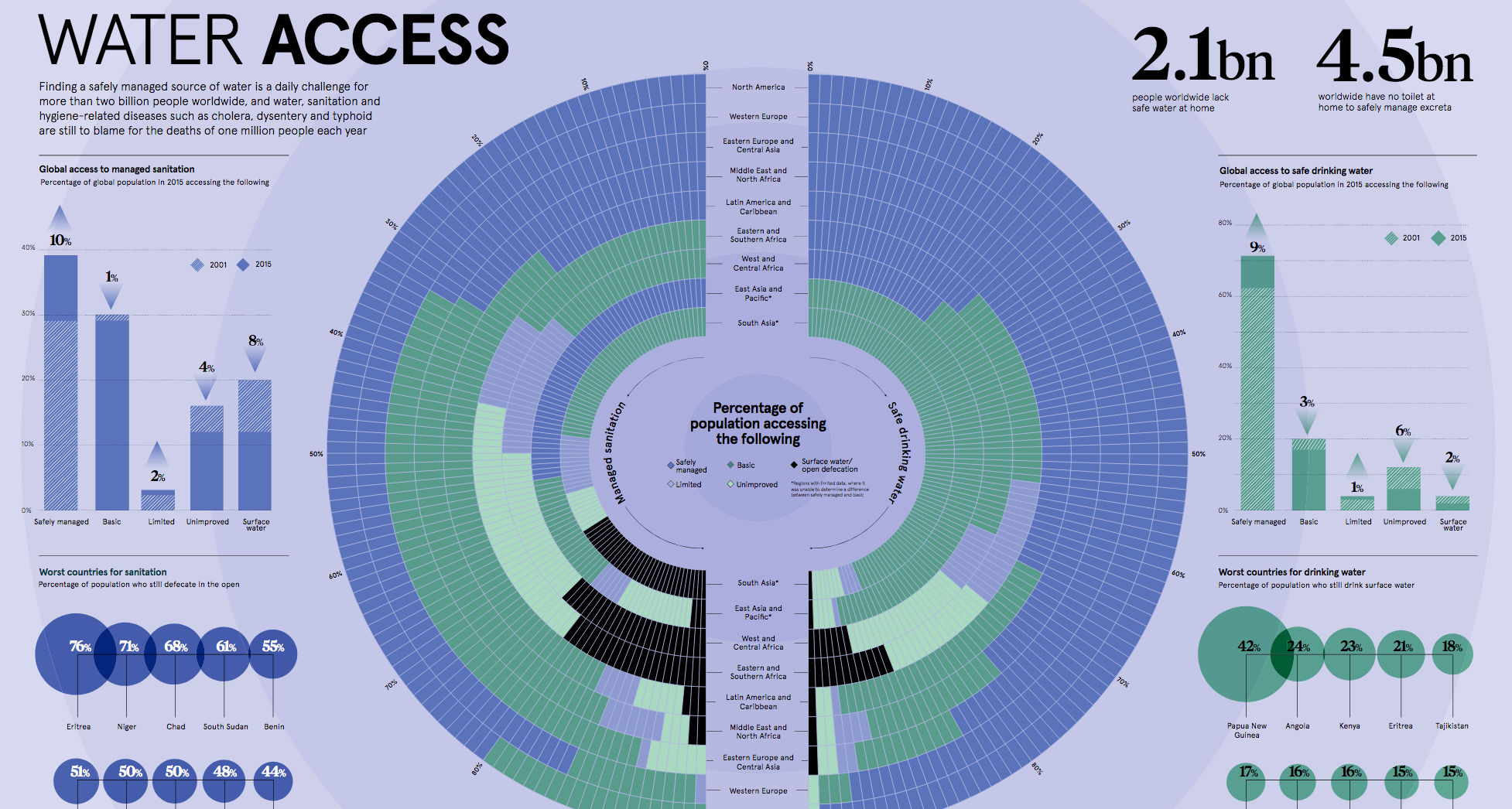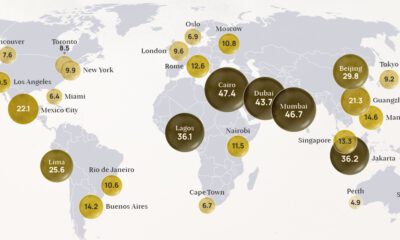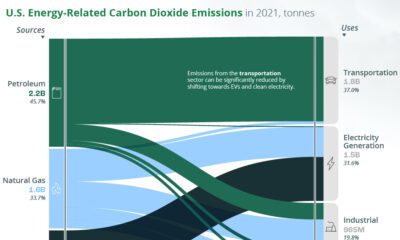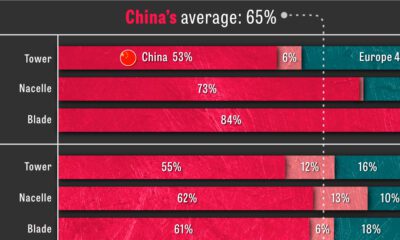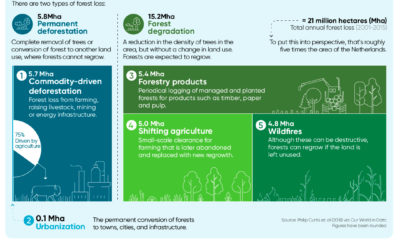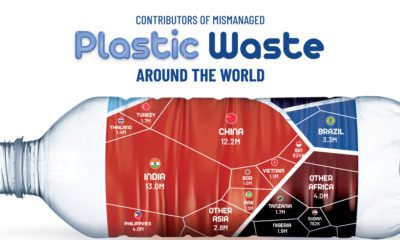Green
The World’s Water Access in One Visualization
View a high resolution version of this graphic.
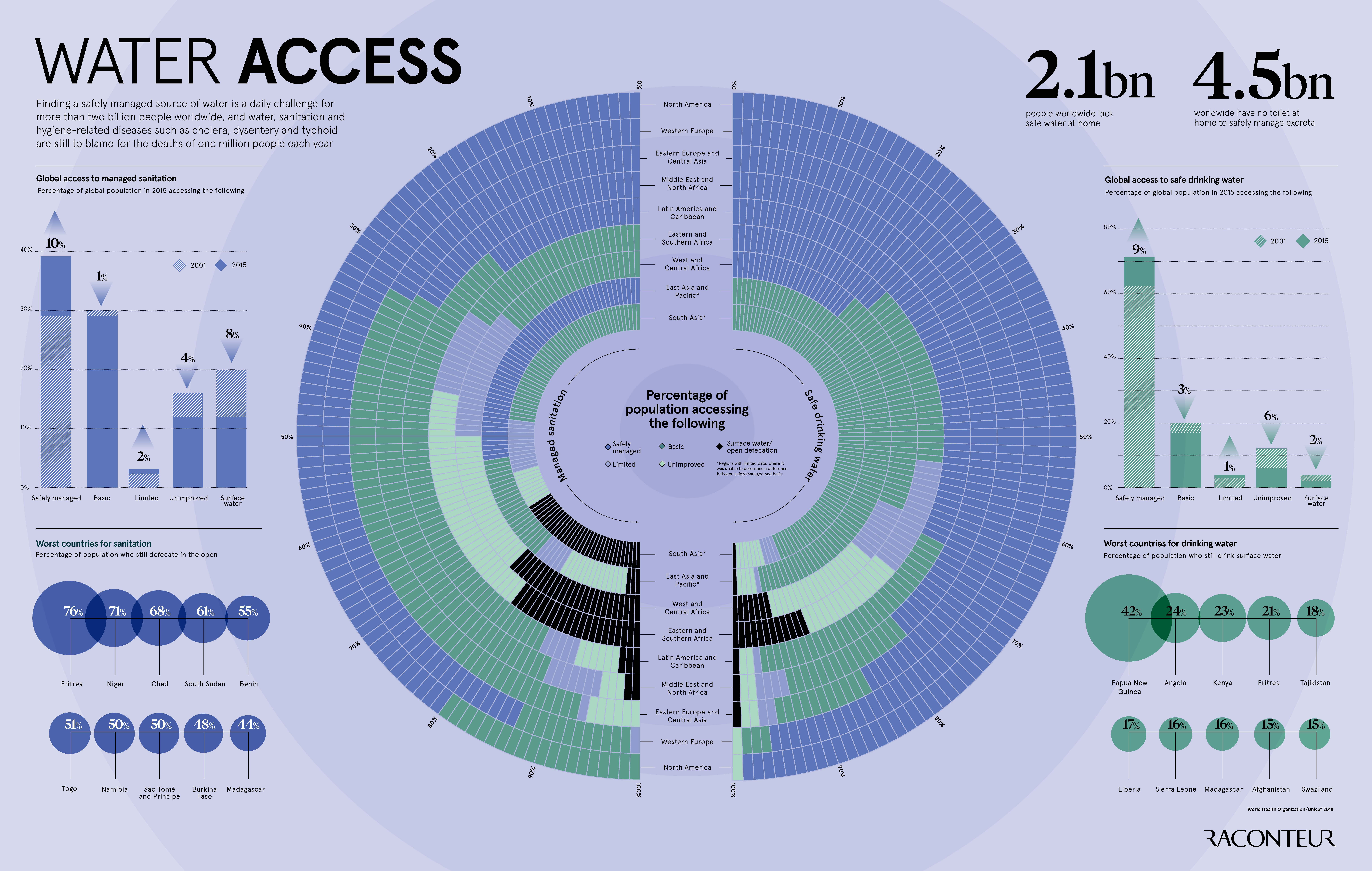
The World’s Water Access in One Visualization
View the high resolution version of today’s graphic by clicking here.
Water is the world’s most vital resource. Beyond its basic functions of sustaining life, it’s also a precious commodity – one that billions of people in the world have trouble accessing.
Today’s infographic is from Raconteur, and it puts the global issue of water access into staggering perspective. It’s a two-fold problem: safe drinking water is hard to come by, while basic access to sanitation is less common than you’d expect.
Diving into Drinking Water
It’s easy to take water for granted when it comes out of every tap in developed economies, but the stark reality is that 2.1 billion people worldwide can’t get safe water this way.
Many people in the world spend hours waiting in long lines, often multiple times a day, for community-shared water, or, they have to travel to distant sources just to collect it.
World regions are categorized according to five classifications for drinking water access.
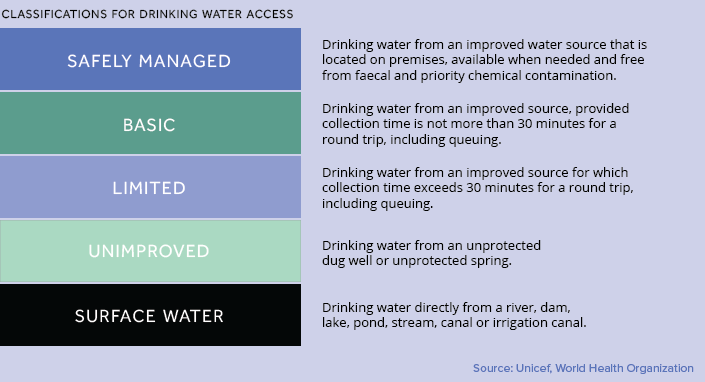
Here’s a breakdown of how each region fares.
| Region | Safely Managed | Basic | Limited | Unimproved | Surface Water |
|---|---|---|---|---|---|
| North America | 99% | - | - | 1% | - |
| Western Europe | 96% | 3% | - | 1% | - |
| Eastern Europe and Central Asia | 84% | 11% | 2% | 2% | 1% |
| Middle East and North Africa | 77% | 16% | 4% | 2% | 1% |
| Latin America and Caribbean | 65% | 31% | 1% | 2% | 1% |
| Eastern and Southern Africa | 26% | 28% | 18% | 16% | 12% |
| West and Central Africa | 23% | 40% | 10% | 20% | 7% |
| East Asia and Pacific | - | 94% | 1% | 4% | 1% |
| South Asia | - | 88% | 4% | 7% | 1% |
The water crisis in Flint, Michigan is a dire exception to the safely managed water rule in North America. After a change in river source in 2014, insufficient water treatment resulted in lead from pipes leaching into the drinking water, affecting over 100,000 residents.
The Struggle of Sanitation
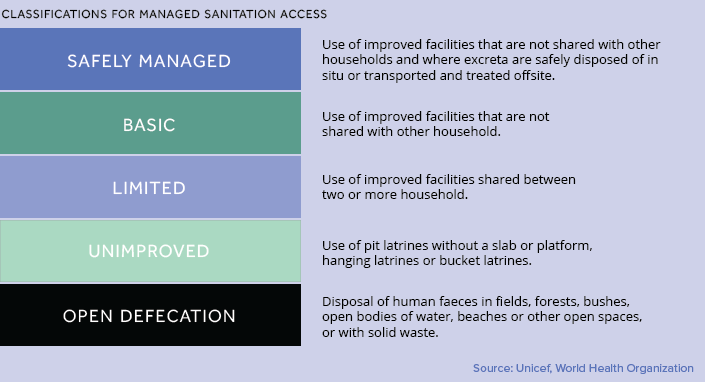
The invention of the toilet in 1875 is credited with saving one billion lives to date. Yet, poor water hygiene and its associated diseases claim the lives of roughly one million people annually.
This is because roughly 4.5 billion people still don’t have access to a toilet, with the problem being particularly acute on the African continent. More than half of the population in Eritrea (76%), Niger (71%), Chad (68%) and South Sudan (61%), for example, do not have any access to even basic sanitation.
Every Drop of Water Counts
According to the World Economic Forum, water has been a top-five global risk for the past seven years.
From an economic perspective, it’s easy to see why:
- An estimated $260 billion is lost globally each year from the lack of basic water and sanitation.
- Almost $18.5 billion in benefits can come from universal access to basic water and sanitation.
Securing water access has profound consequences. For every $1 invested in water and sanitation, there’s a $4 return from lower health costs, higher productivity, and fewer preventable deaths.
Fortunately, progress is being made on the global scale. Between 2001 and 2015, there’s been a 9% improvement in safe drinking water, while safely managed sanitation has risen by 10%.
Green
How Carbon Credits Can Help Close the Climate Funding Gap
To keep a 1.5℃ world within reach, global emissions need to fall by as much as 45% by 2030, and carbon credits could help close the gap.
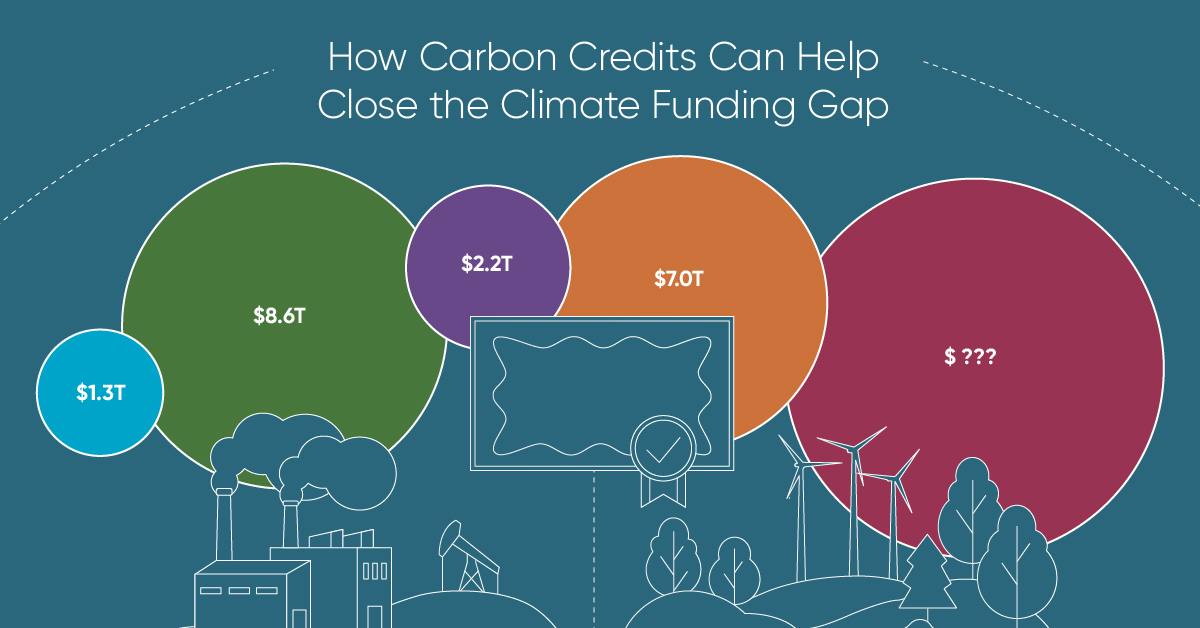
How Carbon Credits Can Help Close the Climate Funding Gap
Governments around the world have committed to the goals of the Paris Agreement, but their climate pledges are insufficient. To keep a 1.5℃ world within reach, global emissions need to fall by as much as 45% by 2030.
Bold and immediate action is essential, but so are resources that will make it happen.
In this graphic, we have partnered with Carbon Streaming to look at the role that the voluntary carbon market and carbon credits can play in closing that gap.
More Funds are Needed for Climate Finance
According to data from the Climate Policy Initiative, climate finance, which includes funds for both adaptation and mitigation, needs to increase at least five-fold, from $1.3T in 2021/2022, to an average $8.6T annually until 2030, and then to just over $10T in the two decades leading up to 2050.
That adds up to a very large number, but consider that in 2022, $7.0T went to fossil fuel subsidies, which almost covers the annual estimated outlay. And the world has shown that when pressed, governments can come up with the money, if the global pandemic is any indication.
Mobilizing Carbon Finance to the Developing World
But the same cannot be said of the developing world, where debt, inequality, and poverty reduce the ability of governments to act. And this is where carbon credits can play an important role. According to analyses from Ecosystem Marketplace, carbon credits help move capital from developed countries, to where funds are needed in the developing world.
For example, in 2019, 69.2% of the carbon credits by volume in the voluntary carbon market were purchased by buyers in Europe, and nearly a third from North America. Compare that to over 90% of the volume of carbon credits sold in the voluntary carbon market in 2022 came from projects that were located outside of those two regions.
Carbon Credits Can Complement Decarbonization Efforts
Carbon credits can also complement decarbonization efforts in the corporate world, where more and more companies have been signing up to reduce emissions. According to the 2022 monitoring report from the Science Based Targets initiative, 4,230 companies around the world had approved targets and commitments, which represented an 88% increase from the prior year. However, as of year end 2022, combined scope 1 and 2 emissions covered by science-based targets totaled approximately 2 GtCO2e, which represents just a fraction of global emissions.
The fine print is that this is just scope 1 and 2 emissions, and doesn’t include scope 3 emissions, which can account for more than 70% of a company’s total emissions. And as these emissions come under greater and greater scrutiny the closer we get to 2030 and beyond, the voluntary carbon credit market could expand exponentially to help meet the need to compensate for these emissions.
Potential Carbon Credit Market Size in 2030
OK, but how big? In 2022, the voluntary carbon credit market was around $2B, but some analysts predict that it could grow to between $5–250 billion by 2030.
| Firm | Low Estimate | High Estimate |
|---|---|---|
| Bain & Company | $15B | $30B |
| Barclays | N/A | $250B |
| Citigroup | $5B | $50B |
| McKinsey & Company | $5B | $50B |
| Morgan Stanley | N/A | $100B |
| Shell / Boston Consulting Group | $10B | $40B |
Morgan Stanley and Barclays were the most bullish on the size of the voluntary carbon credit market in 2030, but the latter firm was even more optimistic about 2050, and predicted that the voluntary carbon credit market could grow to a colossal $1.5 trillion.
Carbon Streaming is Focused on Carbon Credit Integrity
Ultimately, carbon credits could have an important role to play in marshaling the resources needed to keep the world on track to net zero by 2050, and avoiding the worst consequences of a warming world.
Carbon Streaming uses streaming transactions, a proven and flexible funding model, to scale high-integrity carbon credit projects to advance global climate action and UN Sustainable Development Goals.

Learn more at www.carbonstreaming.com.

-

 Green1 week ago
Green1 week agoRanking the Top 15 Countries by Carbon Tax Revenue
This graphic highlights France and Canada as the global leaders when it comes to generating carbon tax revenue.
-

 Green1 week ago
Green1 week agoRanked: The Countries With the Most Air Pollution in 2023
South Asian nations are the global hotspot for pollution. In this graphic, we rank the world’s most polluted countries according to IQAir.
-

 Environment2 weeks ago
Environment2 weeks agoTop Countries By Forest Growth Since 2001
One country is taking reforestation very seriously, registering more than 400,000 square km of forest growth in two decades.
-

 Green3 weeks ago
Green3 weeks agoRanked: Top Countries by Total Forest Loss Since 2001
The country with the most forest loss since 2001 lost as much forest cover as the next four countries combined.
-

 Markets2 months ago
Markets2 months agoThe World’s Top Cocoa Producing Countries
Here are the largest cocoa producing countries globally—from Côte d’Ivoire to Brazil—as cocoa prices hit record highs.
-

 Environment2 months ago
Environment2 months agoCharted: Share of World Forests by Country
We visualize which countries have the biggest share of world forests by area—and while country size plays a factor, so too, does the environment.
-

 Markets1 week ago
Markets1 week agoU.S. Debt Interest Payments Reach $1 Trillion
-

 Business2 weeks ago
Business2 weeks agoCharted: Big Four Market Share by S&P 500 Audits
-

 Real Estate2 weeks ago
Real Estate2 weeks agoRanked: The Most Valuable Housing Markets in America
-

 Money2 weeks ago
Money2 weeks agoWhich States Have the Highest Minimum Wage in America?
-

 AI2 weeks ago
AI2 weeks agoRanked: Semiconductor Companies by Industry Revenue Share
-

 Markets2 weeks ago
Markets2 weeks agoRanked: The World’s Top Flight Routes, by Revenue
-

 Demographics2 weeks ago
Demographics2 weeks agoPopulation Projections: The World’s 6 Largest Countries in 2075
-

 Markets2 weeks ago
Markets2 weeks agoThe Top 10 States by Real GDP Growth in 2023

